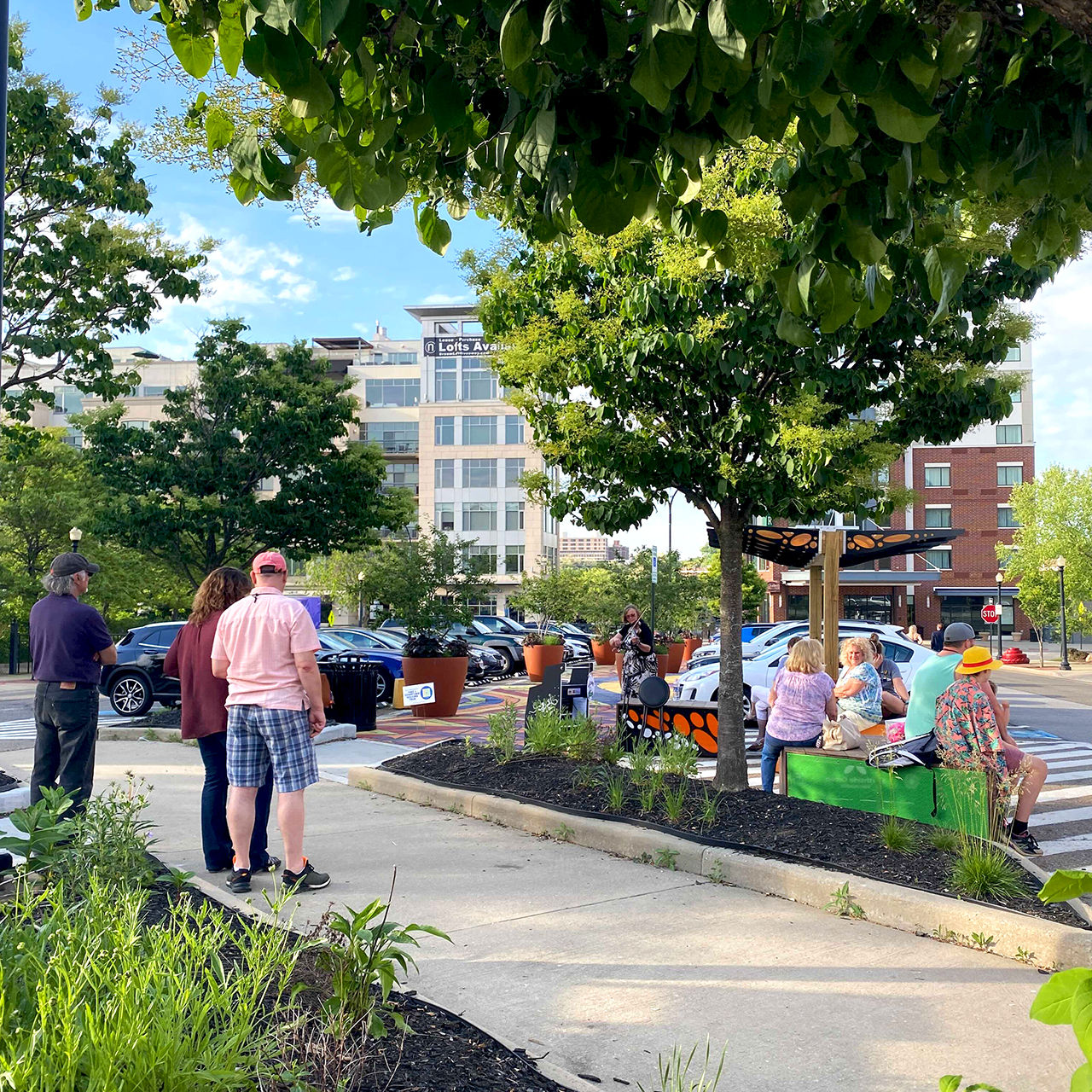The Buzz on the Butterfly Waystation at Downtown Akron's Northside Green
03/22/22
Category: Downtown Akron Blog
In 1997, over a billion monarch butterflies were recorded as they completed their yearly winter migration from the United States to Mexico. Since then, the number declined by about 95%, and only in the past few years have numbers begun to rise again.

Above: A butterfly resting on a flower at the Northside Green (Photo: DAP Staff)
Bees are also facing population decline and habitat loss, due in large part to the industrial agriculture system. The Environmental Protection Agency is worried about these crucial pollinators and what their struggles could do to our food supply, and millions of Americans are, too. And while many states have enacted pollinator-protection legislation in recent years, a lot of people feel a sense of dread about environmental issues. In fact, nearly two thirds of Americans feel the federal government is not doing enough to protect animals and their habitats.
This sense of futility brings up the question: what can we do as individuals and organizations to fill these gaps and support our pollinators? We certainly can’t fix everything, but we can do our small part here in downtown Akron, trusting that all over the world, others are doing their part to take action, too.

Above: People gathered at the Northside Green to enjoy a busking performance (Photo: DAP Staff)
It is in this spirit that Downtown Akron Partnership (DAP) partnered in 2020 with Summit Metro Parks (SMP) and local artist April Nicholson-Couch to update the Northside Green, the colorful public space in the center of what was once an ordinary parking lot adjacent to Luigi’s and Jilly’s Music Room. Committed to creating a vibrant and valuable downtown for all people through space activation, and conscious of the pressing need to act in environmentally responsible, pollinator friendly ways, DAP and SMP created a butterfly waystation to support our pollinators and serve as a space for passersby to enjoy the area.
It features a colorful ground mural filled with butterfly imagery, as well as butterfly-inspired furniture for people to stop, sit, and enjoy the fresh air. In warm weather, the waystation is the perfect place for casual outdoor music performances using a special busking station made by EarthQuaker Devices, or simply to lunch while admiring the artwork. What’s more: the area showcases more than a dozen large planters filled with plants native to our region and beneficial to our local bees and butterflies.
.jpg)
Above: The butterfly-inspired furniture at the Northside Green (Photo: DAP Staff)
Among the plants are serviceberry trees, milkweed, coneflowers, wild geraniums, tufted hair grass, asters, and butterflyweed, all of which attract local pollinators and migrating monarchs. These plants naturally thrive in the region and provide a safe space for our pollinators to feed and find mates.
The Northside Green’s butterfly waystation has been a huge success as a haven for people and pollinators alike. This success has inspired DAP to build on pollinator-friendly approaches to beautification by bringing native plants to flower pots and beds across downtown, where previously, mostly non-native annuals and tropicals existed. Annuals and tropical plants may be beautiful, but they don’t always carry the pollen, nectar, or scent our local bees and butterflies need in order to thrive. Some hybrids are even intentionally bred to omit these things.
If you haven’t yet checked out the butterfly waystation at the Northside Green, we highly encourage you to do so next time you have dinner at Luigi’s or stop at Northside Marketplace.
.jpg)
Above: A busking performance at the Northside Green (Photo: DAP Staff)
For more information on Summit Metro Parks' use of native wildflowers, including recommendations for what you can plant in your own backyard, click here.
For more information on the Northside Green, including how to borrow the busking station, click here.
For information on how industrial agriculture can affect pollinators, click here.
For ideas on what you can do at home to support our pollinators, click here.
And last but not least, for a slightly terrifying, deeply unsettling, yet somehow amusing news story about a national bee expert unleashing 40,000 bees on a crowd in Akron 100 years ago, click here.
Mentioned in this Post
Luigi's
105 N Main St
Jilly's Music Room
111 N Main St
Totally Tangled Creations
140 E Market St
Northside Marketplace
21 Furnace St
Northside Green
106 N Main St